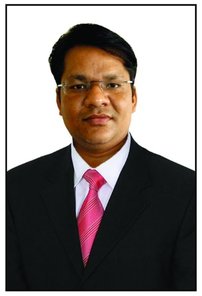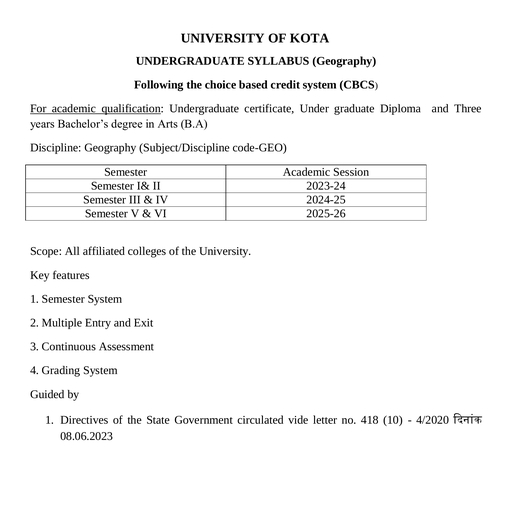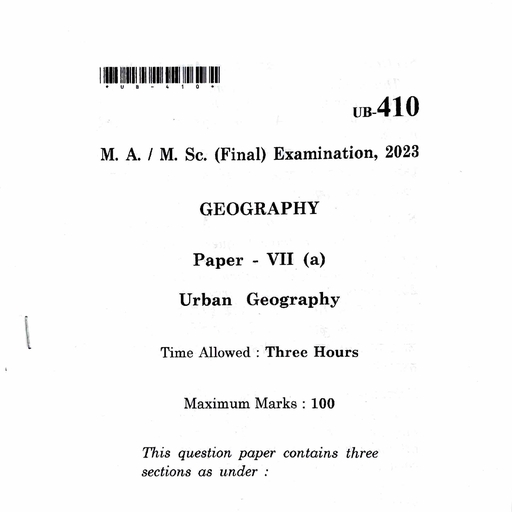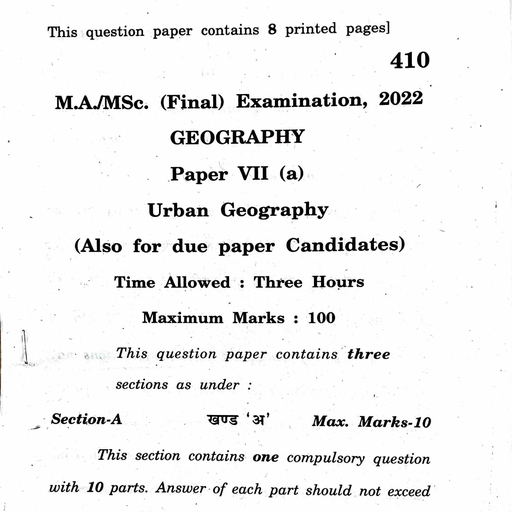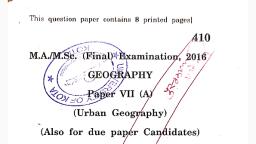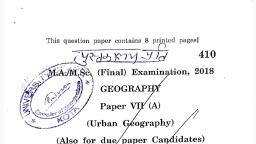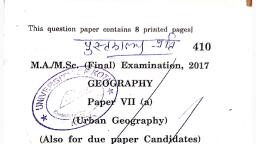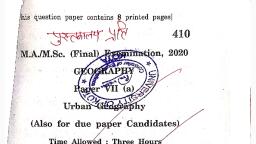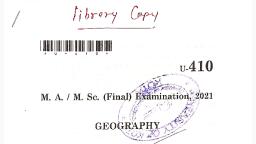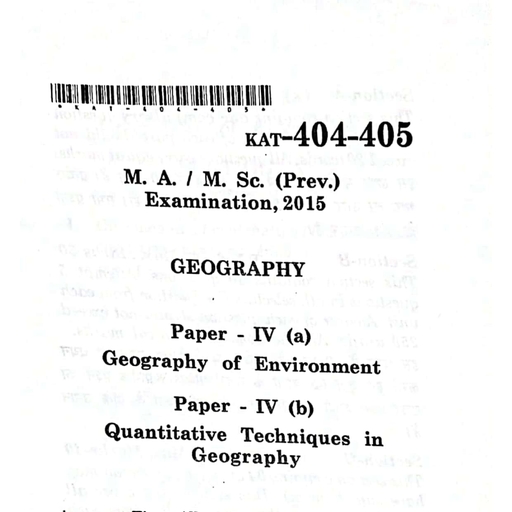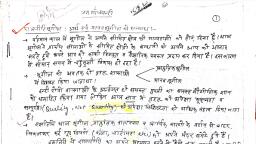Page 2 :
A brief note on the Innovation and the Employability , 1. Now a days Geography has become a very useful subject in various competative examinations, including Civil Services and Rajasthan Administrative Services., , 2. Geography not only deals with the physical, economic and social conditions of the World, India,, Rajasthan but now its nature has become applied and it is helpful in solving the environmental, and urban problems., , 3. Geography provides a background for the regional planning in development and help in, sustainable development., , 4. The modern techniques of Geographical analysis such as Remote Sensing, GIS, GPS etc. are, helpful in Resource and Environmental Management and Disaster Management., , 5. Geography provide an opportunity of employment in various fields. The important are :, , a. Teaching and Research ;, b. Town Planning Departments ;, c. Regional Planning ;, d. Remote Sensing ;, e. Statistical Departments ;, f. Urban/Rural / Agricultural Planning ;, g. Water Resource Departments ;, h. Demographic Study Departments &, i. Administrative Services — Central and State Governments., M.A./M.Sc. (GEOGRAPHY), SCHEME OF EXAMINATION - 2021, Each Theory Paper 3 Hrs. duration Max. Marks:100 marks, Dissertation / Thesis / Survey Report / Field work, if any 100 marks, 1. The number of paper and the maximum marks for each paper, practical shall be shown in the, syllabus for the subject concerned. It will be necessary for a candidate to pass in the theory part, as well as in the practical part (wherever prescribed) of a subject/Paper separately., Pi A candidate for a pass at each of the Previous and the Final Examination shall be required to, obtain (i) at least 36% marks in the aggregate of all the papers prescribed for the examination and, (ii) at least 36% marks in practical(s) wherever prescribed at the examination, provided that if a, candidate fails to secure atleast 25% marks in each individual paper work, wherever prescribed., He shall be deemed to have failed at the examination not with standing his having obtained the, minimum percentage of marks required in the aggregate for that examination. No division will be, awarded at the Previous Examination; Division shall be awarded at the end of the Final, Examination on the combined marks obtained at the Previous and the Final Examination taken, together, as noted below :, First Division 60% of the aggregate marks taken together of, Second Division 48% the Previous and the Final Examination., Rest will be declared to have passed the examinations., 2 If a candidate clears any paper(s), practical(s)/Dissertation prescribed at the Previous and/or Final, , Examination after a continuous period of three years, then for the purpose of working out his, division the minimum pass marks only viz. 25% (36% in the case of practical) shall be taken into, account in respect of such paper(s), practical(s), Dissertation are cleared after the expiry of the, aforesaid period of three year, provided that in case where a candidate require more than 25%, marks in order to reach the minimum aggregate as many marks out of those actually secured by, him will be taken into account as would enable him to make the deficiency in the requisite, minimum aggregate.
Page 3 :
4. The Thesis/Dissertation/Survey Report : Field Work shall be typed & written and submitted in, triplicate so as to reach the office of the Registrar at least 3 weeks before the commencement of, the theory examination. Only, such candidates shall be permitted to offer dissertation/Field, work/Survey report. Thesis (if provided in the scheme of examination) in lieu of a paper as have, secured at least 55% marks in the aggregate of all scheme, irrespective of the number of papers, in which a candidate actually appeared at the examination., , N.B. (i) Non-Collegiate candidates are not eligible to offer dissertation as per provision of 0.170A., , (ii) | A Candidate failing in previous examination may be provisionally admitted to the final, class, provided that he pass in at least 50% papers, as per provisions of 0.235., , (iii) | A candidate may allow grace marks in only one theory paper up to the extent of 1% of the, total marks prescribed for the examination., , M.A./M.Sc. GEOGRAPHY, , There will be four theory papers and a practical each in Previous and Final Examination. Each of, the theory papers will be of 100 Marks. Each theory paper will be of three hours duration. Candidates, will be required to pass both in Theory and Practical separately., , Note : A weekly seminar is to be arranged for M.A. Previous and Final Students., , M.A. / M.Sc. (Previous) Geography, , Paper-I - Evolution of Geographical Thought, , Paper-II - Advanced Physical Geography, Paper-III - Principles and Theory of Economic Geography, Paper-IV - (a) Geography of Environment, or, , (b) Quantitative Techniques in Geography, , Practical :, Distribution of marks will be as follows:, , FF Laboratory and Map work test (4 hours duration) 40 marks, De Record Work 25 marks, J. Viva- Voce 10 marks, 4 Project Report & Viva-Voce (20+05) 25 marks, Total 100 marks, , N.B. _: 12 hours of teaching practical be provided per batch of 10 students per week., , M.A. / M.Sc. (Final) Geography, , Paper-V . Advanced Geography of India, Paper-VI - Any one of the following , (a) Agricultural Geography, , (b) Industrial Geography, , (c) Geography of Transport and Marketing, Paper-VII - Any one of the following , (a) Urban Geography
Page 4 :
(b) Population and Settlement Geography, (c) Bio-Geography, , Paper-VIII_ - Any one of the following (a) Political Geography, (b) Research Methodology, (c) Regional Planning and Development, (d) Remote Sensing and GIS, , Dissertation in lieu of VI or VII or VIII papers., , Practical :, The distribution of marks in the Practical will be as follows:, , 1, , 2., 3., 4., , N.B., , Laboratory work of three hours duration 40 marks, Record work and Viva-Voce (15+05) 20 marks, Field Surveying and Viva-Voce (15+05) 20 marks, Survey Camp Report and Viva-Voce (15+05) 20 marks, Total 100 marks, , : 12 hours of teaching practical be provided per batch of 10 students per week., , Instruction for Geography Practical Examination:, , 1., , The record work should have 50 sheets (1/6" of 20"x30") and they should cover the total syllabus, proportionately. The teacher should give fresh exercise every time so that the students may not, undertake tracing of old exercise. The work must be done in the class room and signed on the, same date. This would discourage completing the whole work at the nick of the examination., Viva-Voce Examination be held to judge the real knowledge of the students and to examine the, authenticity of the record work. The marking on record work and its Viva-Voce be based on the, original work of the candidate and not merely producing the record work get done by any other, agency. Marks be deducted for the part of the syllabus not covered., , On an average about 20 students be examined in one day. In M.A. Previous as far as possible in, one practical exercise be set to judge the practical skill., , The External Examiners, be provided syllabus and detailed instructions at the time of obtaining, his consent. For M.A./M.Sc. Final a minimum of two days be fixed to conduct the examination., , Note : A copy of the instructions be sent to the examiners for their information.
Page 5 :
M.A. / M.Sc. (Final)- 2021, Paper V- Advanced Geography of India, , Duration - 3 hours Max. Marks - 100, Note : The question paper will contain three sections as under —, Section-A : One compulsory question with 10 parts, having 2 parts from each unit, short, , answer in 20 words for each part. Total marks : 10, Section-B: 10 questions, 2 questions from each unit, 5 questions to be attempted, taking one, from each unit, answer approximately in 250 words. Total marks : 50, , Section-C : 04 questions (question may have sub division) covering all units but not more, than one question from each unit, descriptive type, answer in about 500 words, 2, questions to be attempted. Total marks : 40, , Unit - I, Physiographic and Drainage systems. Soils, Vegetation, Origin and Mechanism of Indian Monsoon., Schemes of Natural Physiographic and Climate Classifications. Identification of Drought and Flood, Prone Areas., , Unit -II, Tribal areas and their problems, Population Growth, Distribution, Density, Sex Ratio and Literacy,, Population problems and policies. Urbanization in India., , Unit -IIT, Resources: conservation and utilization of land, mineral, water, biotic and marine resources., Agricultural land use pattern, Green revolution and its impact on Indian Agriculture. Agriculture, infrastructure - Irrigation, Fertilizers and Seeds, Dry zone Agriculture. Agro-Climatic Regions of India., , Unit -IV, Industry - factors of localization, classification and detailed study of the following-Iron and Steel,, , Cement, Fertilizer, Paper and Pulp and Sugar Industries. Study of the Network of Road, Railways,, Airways and Water ways. Regional disparities in development in India., , Unit -V, Geographical study of Rajasthan under the following heads: Relief, Climate, Vegetation, Soils,, , Agricultural development, Irrigation, Mineral and Power resources, Industrial development, Detailed, study of the following regions , 1. Marusthali 2. Aravali 3. Eastern Plain 4. Hadoti Plateau
